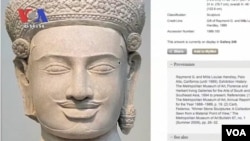LOS ANGELES - Two empty pedestals at Koh Ker temple, in Siem Reap province, mark a battleground that has big implications for Western museums. They are the feet of two looted statues that ended up in America.
The Cambodian government has filed suit in a US court to have a statue that was looted from this site seized from the giant auction house Sotheby’s. And now Cambodian officials say they are considering asking US museums for the return of their stolen objects.
Jason Felch, an investigative reporter for the Los Angeles Times and an author on a book about the antiquities trade, says the case is drawing battle lines.
“On the one side, you have museums and private collectors, who argue passionately that these objects are really best off in these big museums where a lot of people can access them, where scholars can study them,” he says. “On the other hand, you have source countries, countries that have been the subject of lots of looting, who have lost a lot of their cultural heritage. And they’re saying, ‘Look, your beautiful museum is the result of our plunder, and we want some of those objects back.’”
The question is whether these antiquities were looted from the country before there were laws that might require their return. Both museums and Sotheby’s argue it is unknown when the statues were looted.
Cambodia believes it has a strong case to argue for the return of the Koh Ker statue at Sotheby’s. And a Cambodian cultural official told the New York Times in June Cambodia could ask for the return of a pair of statues from the Metropolitan Museum.
Cambodia would see this as a return to some of its lost heritage. “But museums would see them as an assault on their whole mission, which is to gather these objects under one roof and to encourage us to think across cultures,” Felch says.
But Cambodia, with its bustling tourism at Angkor Wat, has a mission of its own.
“Instead of people going to New York to see Khmer art, the Cambodians would like to see people go to Phnom Penh, to the National Museum, to see these real icons of culture,” Felch says.
For now, it remains to be seen whether Cambodia will pursue the statues at the Metropolitan, the Norton Simon or other Western museums. Both museums have defended their right to maintain their collections of Khmer works.
Either way, Cambodia’s claims shine light on another side of the antiquities trade.
“What’s also clear is that museums have been in essence doing business with the black market, by encouraging the market, by paying really top dollar prices for these objects,” Felch says.
In the Sotheby’s case, Cambodia would like the US government to seize the Koh Ker statue and prevent its sale. The case has gone to US court and could take a long time to sort out. Tess Davis is a preservationist who has advised the Cambodian government on seeking the return of such works.
“This case is far from over," she says. "It could be resolved quickly, it could take years to resolve, but either way, I think it’s a huge step forward for Cambodia, no matter the outcome. It’s brought a lot of attention to the illicit trade in Cambodian antiquities, and the Cambodian government has shown real courage in taking on a powerful international corporation.”
The Cambodian government has filed suit in a US court to have a statue that was looted from this site seized from the giant auction house Sotheby’s. And now Cambodian officials say they are considering asking US museums for the return of their stolen objects.
Jason Felch, an investigative reporter for the Los Angeles Times and an author on a book about the antiquities trade, says the case is drawing battle lines.
“On the one side, you have museums and private collectors, who argue passionately that these objects are really best off in these big museums where a lot of people can access them, where scholars can study them,” he says. “On the other hand, you have source countries, countries that have been the subject of lots of looting, who have lost a lot of their cultural heritage. And they’re saying, ‘Look, your beautiful museum is the result of our plunder, and we want some of those objects back.’”
The question is whether these antiquities were looted from the country before there were laws that might require their return. Both museums and Sotheby’s argue it is unknown when the statues were looted.
Cambodia believes it has a strong case to argue for the return of the Koh Ker statue at Sotheby’s. And a Cambodian cultural official told the New York Times in June Cambodia could ask for the return of a pair of statues from the Metropolitan Museum.
Cambodia would see this as a return to some of its lost heritage. “But museums would see them as an assault on their whole mission, which is to gather these objects under one roof and to encourage us to think across cultures,” Felch says.
But Cambodia, with its bustling tourism at Angkor Wat, has a mission of its own.
“Instead of people going to New York to see Khmer art, the Cambodians would like to see people go to Phnom Penh, to the National Museum, to see these real icons of culture,” Felch says.
For now, it remains to be seen whether Cambodia will pursue the statues at the Metropolitan, the Norton Simon or other Western museums. Both museums have defended their right to maintain their collections of Khmer works.
Either way, Cambodia’s claims shine light on another side of the antiquities trade.
“What’s also clear is that museums have been in essence doing business with the black market, by encouraging the market, by paying really top dollar prices for these objects,” Felch says.
In the Sotheby’s case, Cambodia would like the US government to seize the Koh Ker statue and prevent its sale. The case has gone to US court and could take a long time to sort out. Tess Davis is a preservationist who has advised the Cambodian government on seeking the return of such works.
“This case is far from over," she says. "It could be resolved quickly, it could take years to resolve, but either way, I think it’s a huge step forward for Cambodia, no matter the outcome. It’s brought a lot of attention to the illicit trade in Cambodian antiquities, and the Cambodian government has shown real courage in taking on a powerful international corporation.”









